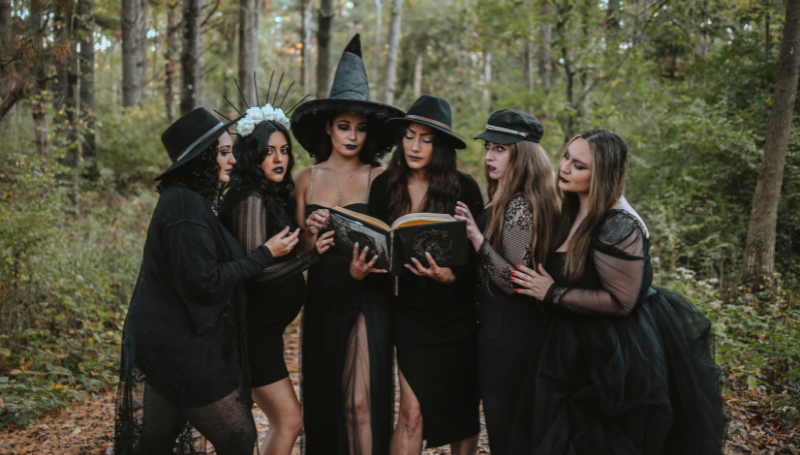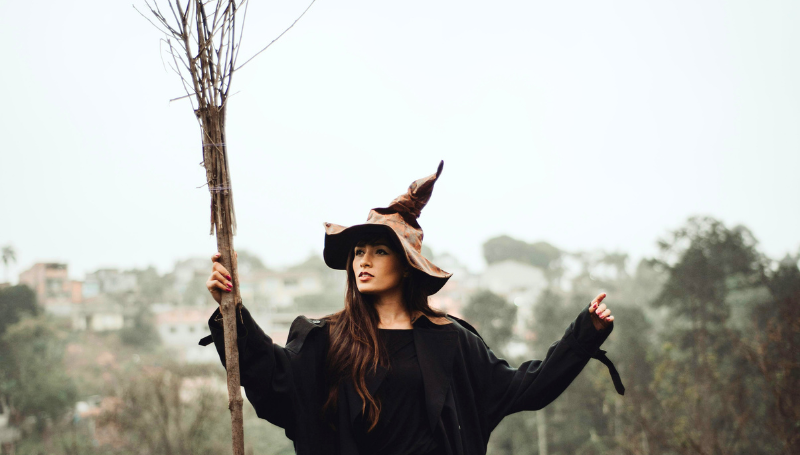Embracing the craft: Which of the 22 types of witches are you?
(Global Heart) Discover the magic! Are you a kitchen, green, or cosmic witch? Explore 22 powerful types of witches.
Find your craft: A guide to the 22 paths of modern magic
Witches and witchcraft—practices once feared and suppressed—have been experiencing a vibrant resurgence since the mid-20th century, walking hand-in-hand with other ancient wisdom like seasonal living, moon rituals, and astrology. Take a scroll through social media, and you’ll find women boldly reclaiming the word “witch,” infusing it with new meaning and power. This reclaiming is long overdue. But as you look closer, you’ll see a vast, beautiful spectrum of aesthetics, practices, and magic.
So, what exactly defines a witch today, and with so many paths, how do you even begin to choose your own practice?
Redefining the witch: beyond the caricature
For centuries, books and films painted a chilling, one-dimensional picture: a green-faced crone cackling over a cauldron, practicing black magic, and terrorizing the innocent. This image is a malicious caricature, manufactured and popularized by fearful men to stigmatize, demonize, and control powerful women.
A true witch is something else entirely. She is an untamed, unapologetic, sovereign woman deeply rooted in her power. She lives and works in harmony with Mother Nature and the Goddess. A witch is connected to her own inner magic, using it to navigate, create, and manifest from the subtle realm into the physical world. She is, simply put, a woman who lives life completely on her own terms—a woman they could not burn.
Today, women worldwide are awakening to this sacred, repressed part of themselves, returning to wholeness and reclaiming the power that runs through their veins.
How the truth became twisted
Before the witch hysteria and trials swept through Europe, witches were wise women, medicine women, midwives, and healers—integral members of every community. They used their deep knowledge of herbs, plants, and energy to craft remedies, assist in childbirth, and advise on agricultural cycles.
However, with the rise of Christianity, texts like the Bible and the widely circulated The Hammer of the Witches (a book detailing why witches were evil and how to “catch” them) fueled a reign of terror. The result was a mass arresting, torturing, and murdering of millions of women—an atrocity often swept under the rug compared to other historical events, with the Salem Witch Trials being one of the most notorious examples.
Any strong, independent woman—whether she owned a cat, had knowledge of herbs, or could read the future in cards—was branded a witch. This fear was weaponized to disconnect women from their power and to exercise control over people, land, and the emerging capitalist structures. Even today, fear and accusation persist in some cultures. Don’t let this history scare you; instead, let it galvanize you to reclaim your power and your magic.
Witchcraft is for everyone
The modern-day witch is wonderfully diverse. There are so many types of modern witchcraft now that it is perfectly okay—and encouraged—to take what resonates and leave the rest. There are no rigid rules!
A woman is not “less” of a witch if she doesn’t come from a long ancestral line of practitioners. If you love charging a crystal in your bath, do regular oracle readings, celebrate full moon rituals, or infuse your cooking with intention, you are just as much a witch as any other. Witchcraft is accessible to everyone.
Essential tools for the craft
Many witches create a sacred altar—a dedicated space to store their tools, perform spell work, practice moon rituals, and meditate. While the practices are personal, here are some common tools you might find:
- Crystals, stones, and gems
- A small journal (often called a Book of Shadows) to track rituals and spells
- Tarot or oracle cards
- Candles and incense
- A wand, athame (ceremonial knife), or small chalice/cauldron
- A variety of herbs, flowers, and essential oils
- Inspiring images and handwritten affirmations
All these items help amplify your magic. Now that you have an idea of the fundamental concepts and tools, let’s explore the vast spectrum of the craft.

22 paths to magic: Which witch are you?
Today, no two witches are exactly alike. Explore this list of 22 types of witches and notice which ones call to your soul. Remember: you are not confined to just one!
Connecting to tradition and lineage
- Traditional Witch (or folk/hereditary witch): Practices the magic, spells, and customs passed down through her matriarchal line or local community. This craft often predates Wicca, rooted in ancient knowledge of the land.
- Gypsy Witch: Typically from a line of Romani Gypsies, often using the Romani word shuvihani (“wise woman”). They harness herbs and divination for special rites like weddings and baby blessings.
- Celtic Witch: Stays true to Celtic myths, rituals, and the pre-Christian Pagan religion. They honor their lineage, the Ancients, the Earth, and often focus on healing.
Rooted in nature and the earth
- Green Witch: Draws power from Mother Nature, specifically plants, flowers, and herbs, which they use in spells and remedies. You might be one if you love being outdoors and tending a garden.
- Hedge Witch: Works alone, often focusing on nature, elements, herbs, and crafts to create healing remedies. She focuses on developing her own simple, fuss-free magic, sometimes involving “hedge-riding” (astral projection).
- Sea Witch: Connected to the element of water, particularly the ocean. She incorporates found materials like shells, sand, driftwood, and salt into her potions and spells, drawing power from proximity to vast bodies of water.
- Elemental Witch: Bases her entire practice on and draws power from the elements: Earth, water, fire, and air (sometimes Spirit). She must form a deep bond with each element to call upon them in her spell work.
- Faery Witch: A blend of the Wiccan and Celtic witch, inspired by Irish mythology. They often perform rituals outdoors in nature, drawing power from their surroundings, forests, and springs.
Magic in the home and hearth
- Kitchen Witch: Turns the act of preparing a meal into a sacred, magical act. Her stove or counter is her altar, and her tools are fresh ingredients, herbs, spices, and recipes (spells). A very common type of modern witch!
- Hearth Witch (or Cottage Witch): The Hearth Witch, also known as the Cottage Witch, embodies the “heart and soul” of the home. Her practice is devoted to transforming a simple dwelling into a sacred, nurturing space. Combining elements of both the Green and Kitchen Witch, her magic is primarily focused indoors. You’ll find her directing her energy into crafting—perhaps making candles, crocheting, or creating wreaths from foraged materials—constantly infusing her environment with beauty and powerful intention.
Working with the cosmos and spirit
- Cosmic Witch: Gains power from the stars, paying close attention to astrology, astronomy, and the moon cycle. She uses deep knowledge of birth charts, signs, and planetary movements to navigate life.
- Lunar Witch: Dedicated solely to the power of Grandmamma Moon. She harnesses its feminine energy by observing rituals at each phase of the lunar cycle, planning her life accordingly, and using the moonlight to recharge her tools.
- Crystal Witch: Harnesses the energy of crystals, stones, and gems in rituals and spell work to amplify energy, manifest desires, and draw things toward them. Often attuned to auras and subtle energy.
- Divination Witch (or Augury Witch): Focuses on the future, using magic to predict what’s ahead. She works with tools like tarot cards, oracle cards, pendulums, palm reading, and tassology (interpreting tea leaves).
- Shamana Witch: The Shamana Witch, also known as a female shaman or medicine woman, embodies the roles of priestess, healer, herbalist, sorceress, and mentor. Rooted in ancient Paganism, her practice often involves drumming, dancing, and the use of sacred plants to enter altered states of consciousness, facilitating powerful healing, spells, and ceremonies.
Modern blends and movements
- Baby Witch: A term for someone brand new to witchcraft, exploring and experimenting with multiple paths to find what excites her and pave her own unique way.
- Eclectic Witch: Can’t choose just one! She cherry-picks the practices, beliefs, and rituals she feels drawn to from all different types of witchcraft. She combines historical sources, online teachings, and inspiration from others to create a personal blend.
- Bruja Witch: “Bruja” means “witch” in Spanish. This branch refers to witches from a line of Hispanic healers, which has seen a recent rise in popularity as Latina and Hispanic women reclaim their heritage. They engage in various rituals, divination, cleansing, and energy work, often using herbs, spices, lemons, and limes.
Group and solitary practice
- Coven Witch: Operates as part of a community (traditionally 13 witches) to combine their magic and power for stronger spells and collective manifestation. They enjoy engaging in sacred ceremonies and rituals together.
- Solitary Witch: The opposite of a Coven Witch. She prefers to work alone, not following any specific rules, practicing her own blend of magic, and being in complete control of her craft.
- Wiccan Witch: Practices Wicca, a modern, nature-based religion rooted in witchcraft traditions. They celebrate the Wheel of the Year (festivals like Samhain and Yule) and worship both a Goddess and a God. Their main rule is “to not harm anyone with their magic.”
- Dianic Witch: A strictly all-female coven focused on worshiping the Roman Goddess Diana and the divine feminine. Everything they believe and practice comes through a feminist lens, often focusing on the Maiden, Mother, Crone triad.
Which path calls to you?
Regardless of where you are on your journey, this list provides a rich foundation for exploring witchcraft. It’s important to remember that being a witch isn’t ultimately about possessing magical powers or casting spells; it’s about who you are on a deep, soul level and what you choose to believe.
Don’t take anything as gospel. Tap into and trust your intuition and let it guide you as you immerse yourself in this world and powerfully reclaim the word ‘witch’.
Which types of witches on this list speak to your soul and get you excited to explore your own innate magic?
Source: Global Heart
You may also like:





